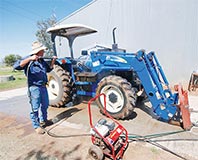Read the latest information on
Foot-and-mouth disease

Nigel Brumpton enforces a strict cleaning and wash-down policy on his properties to control the spread of weed seeds. Image courtesy of Queensland Murray-Darling Committee
An on-farm clean-down facility is one of the central components of farm biosecurity for Nigel and Rosemary Brumpton at their property ‘Baynham’, in Mitchell in Queensland. Careful attention to vehicle and machinery cleanliness has always been a priority, with a particular focus on preventing incursions of parthenium weed (Parthenium hysterophorus).
The Brumptons strongly believe that prevention is better than cure. “There’s a lot of parthenium coming down the river from the north,” Nigel says, “and we don’t want it on our property – it seeds too readily and is too hard to get rid of.”
The Brumptons’ property is 8000 hectares and they run a mixed enterprise including 1000 ha under cultivation. They graze cattle and sheep and have two sheep studs: Mt Ascot Merino and Jolly Jumbuck Poll Merino. In winter they grow fodder crops and in summer they add cash crops including mungbeans.
The diversity of their enterprise means they have many contractors entering the property, which the Brumptons have identified as their greatest potential biosecurity risk. As a result, they have a strict policy that only clean machinery and vehicles are allowed on the property. “We only allow vehicles or machinery on to the property after assessing the risk of bringing parthenium,” Nigel says.
Before engaging contractors, the Brumptons undertake a risk analysis. Essentially, they ask where else they have been working. “If they have been working in central Queensland or in a known parthenium area then they just won’t get the job – the risk that they will have parthenium is just too high,” Nigel says.
About 10 years ago they installed a clean-down facility on the property to ensure that machinery and vehicles could be thoroughly cleaned. “If they have not been working in a high-risk area then we get them to clean down thoroughly before entering the property. When they turn up we inspect the vehicle or machinery and if it is not up to standard we get them to clean down again.”
Two years ago the Brumptons took advantage of a project that they heard about from their local Landcare officer to upgrade their wash-down facility. “Queensland Murray-Darling Committee was running a project funded by Santos where producers were able to access money to develop or upgrade on-farm clean-down facilities,” Nigel says. “We were one of the lucky producers to be accepted into the project, so we were able to upgrade our facility and add high-pressure air blow-down as well because sometimes blowing down is more appropriate or effective.”
“We also use the facility for cleaning down our own vehicles and equipment if they have been off the property and into an area that may be contaminated.”
The upgrade includes a sloping cement slab, a pressure washer, a storage shed and cleaning equipment. In terms of design, his advice to others installing a wash bay is to keep it simple. “Don’t make it too sophisticated. As long as water runs off one end and you can check for weeds and the germination of any weed seeds, it should work well,” Nigel says.
When the Brumptons buy stock it is usually from Roma saleyards, which have good clean-down facilities. Stock carriers are not necessarily kept clean so they take precautions with the new arrivals. Upon delivery, new animals are kept in a yard for a while to ensure they are weed and disease-free, while a careful eye is kept on the road leading to the yards for any new weeds.
Hunters and pig shooters are also a big concern in the area, as are feral pigs and dogs, and kangaroos, all of which can spread weeds and disease. To reduce these risks the Brumptons were one of the early adopters of exclusion fencing. The property is completely fenced with 1.8-metre fencing that keeps out dogs, pigs and kangaroos. The Brumptons say it is important to have control over their own destiny.
Not everyone is happy about the strict clean-down requirements and having to conform to such a high level of scrutiny, but Nigel is unapologetic: “I don’t have time to chase around after new weeds and pests, particularly parthenium.”
Acknowledgement
Reproduced from an article written by Grains Biosecurity Officer Kim McIntyre for GRDC’s Ground Cover magazine